2012 RENAULT SANDERO check engine light
[x] Cancel search: check engine lightPage 18 of 183
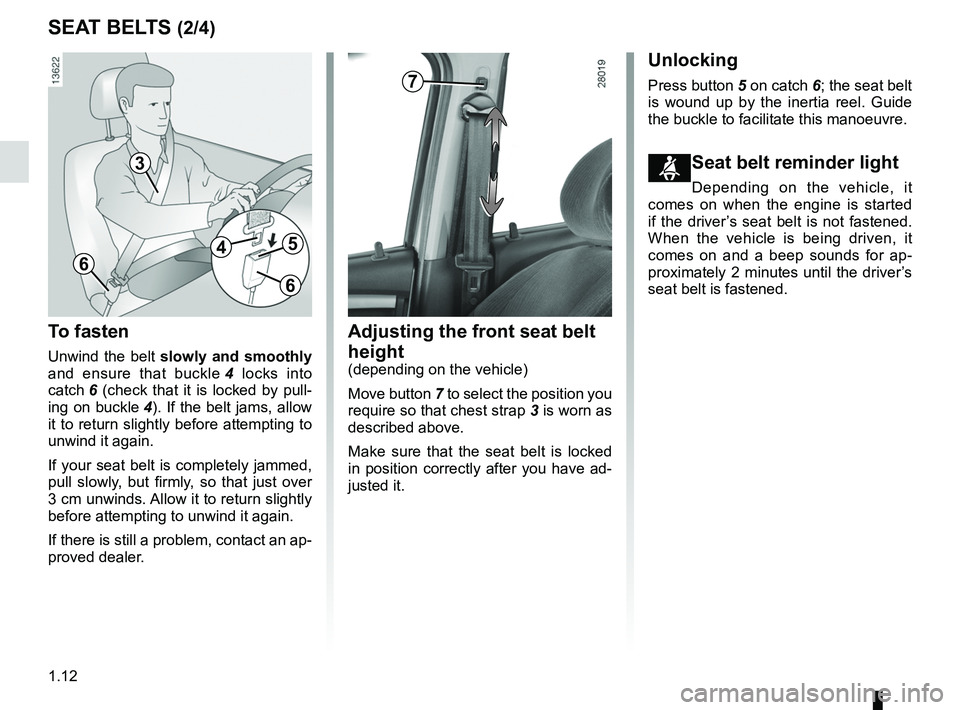
1.12
ENG_UD22593_8
Ceintures de sécurité (B90 - Dacia)
ENG_NU_817-9_B90_Dacia_1
Jaune NoirNoir texte
Adjusting the front seat belt
height
(depending on the vehicle)
Move button 7 to select the position you
require so that chest strap 3 is worn as
described above.
Make sure that the seat belt is locked
in position correctly after you have ad-
justed it.
To fasten
Unwind the belt slowly and smoothly
and ensure that buckle 4 locks into
catch 6 (check that it is locked by pull -
ing on buckle 4). If the belt jams, allow
it to return slightly before attempting to
unwind it again.
If your seat belt is completely jammed,
pull slowly, but firmly, so that just over
3 cm unwinds. Allow it to return slightly
before attempting to unwind it again.
If there is still a problem, contact an ap-
proved dealer.
6
3
45
6
7
SEAT BELTS (2/4)
Unlocking
Press button 5 on catch 6; the seat belt
is wound up by the inertia reel. Guide
the buckle to facilitate this manoeuvre.
ßSeat belt reminder light
Depending on the vehicle, it
comes on when the engine is started
if the driver’s seat belt is not fastened.
When the vehicle is being driven, it
comes on and a beep sounds for ap -
proximately 2 minutes until the driver’s
seat belt is fastened.
Page 47 of 183
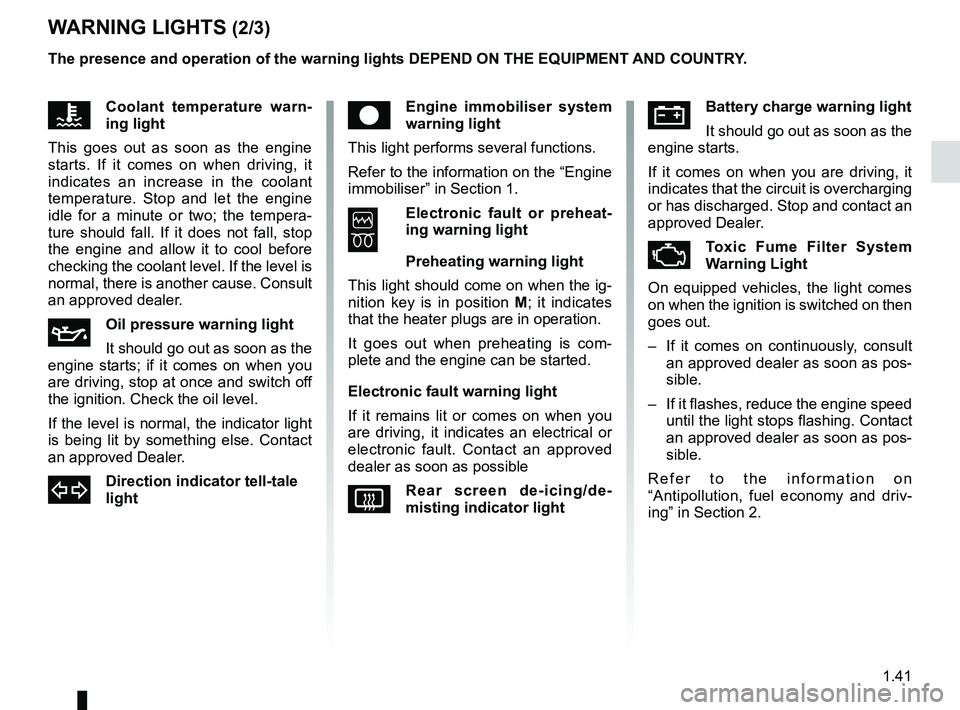
JauneNoirNoir texte
1.41
ENG_UD19003_9
Tableau de bord : témoins lumineux (B90 - L90 Ph2 - F90 Ph2 - R90 Ph2\
- Dacia)
ENG_NU_817-9_B90_Dacia_1
W ARNING LIGHTS (2/3)
êEngine immobiliser system
warning light
This light performs several functions.
Refer to the information on the “Engine
immobiliser” in Section 1.
6
Electronic fault or preheat -
ing warning light
Preheating warning light
This light should come on when the ig-
nition key is in position M; it indicates
that the heater plugs are in operation.
It goes out when preheating is com -
plete and the engine can be started.
Electronic fault warning light
If it remains lit or comes on when you
are driving, it indicates an electrical or
electronic fault. Contact an approved
dealer as soon as possible
VRear screen de-icing/de -
misting indicator light
ÚBattery charge warning light
It should go out as soon as the
engine starts.
If it comes on when you are driving, it
indicates that the circuit is overcharging
or has discharged. Stop and contact an
approved Dealer.
ÄToxic Fume Filter System
Warning Light
On equipped vehicles, the light comes
on when the ignition is switched on then
goes out.
– If it comes on continuously, consult
an approved dealer as soon as pos-
sible.
– If it flashes, reduce the engine speed
until the light stops flashing. Contact
an approved dealer as soon as pos-
sible.
R e f e r t o t h e i n f o r m a t i o n o n
“Antipollution, fuel economy and driv -
ing” in Section 2.
The presence and operation of the warning lights DEPEND ON THE EQUIPMENT\
AND COUNTRY.
ÔCoolant temperature warn
-
ing light
This goes out as soon as the engine
starts. If it comes on when driving, it
indicates an increase in the coolant
temperature. Stop and let the engine
idle for a minute or two; the tempera -
ture should fall. If it does not fall, stop
the engine and allow it to cool before
checking the coolant level. If the level is
normal, there is another cause. Consult
an approved dealer.
ÀOil pressure warning light
It should go out as soon as the
engine starts; if it comes on when you
are driving, stop at once and switch off
the ignition. Check the oil level.
If the level is normal, the indicator light
is being lit by something else. Contact
an approved Dealer.
dDirection indicator tell-tale
light
Page 48 of 183
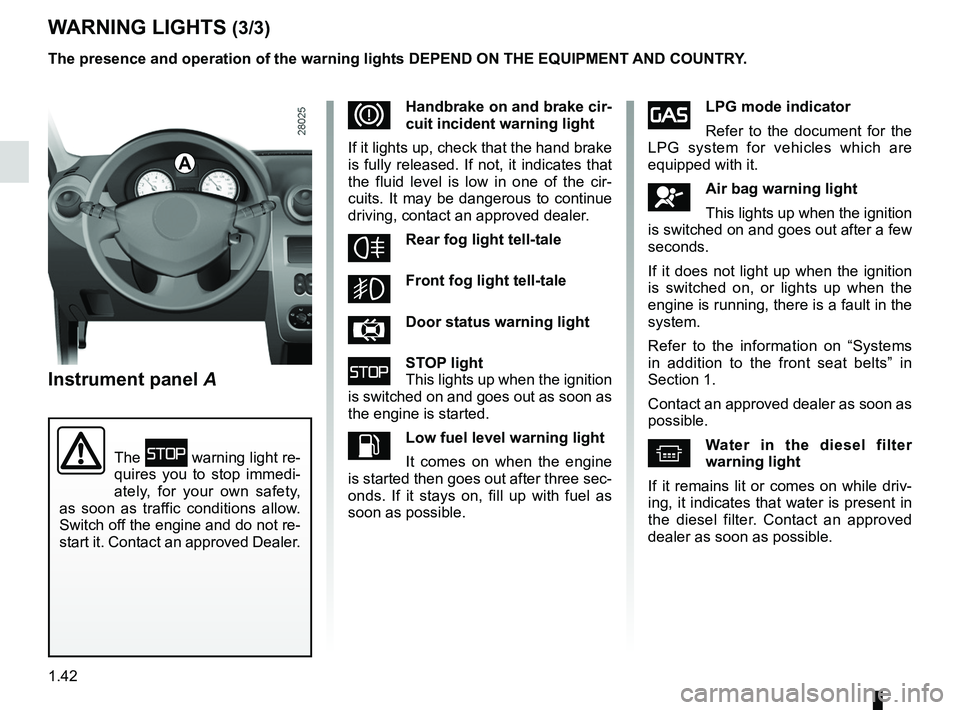
rear screendemisting ......................................................... (current page)
1.42
ENG_UD19003_9
Tableau de bord : témoins lumineux (B90 - L90 Ph2 - F90 Ph2 - R90 Ph2\
- Dacia)
ENG_NU_817-9_B90_Dacia_1
W ARNING LIGHTS (3/3)
The presence and operation of the warning lights DEPEND ON THE EQUIPMENT\
AND COUNTRY.
DHandbrake on and brake cir-
cuit incident warning light
If it lights up, check that the hand brake
is fully released. If not, it indicates that
the fluid level is low in one of the cir -
cuits. It may be dangerous to continue
driving, contact an approved dealer.
fRear fog light tell-tale
gFront fog light tell-tale
ÅDoor status warning light
ûSTOP light
This lights up when the ignition
is switched on and goes out as soon as
the engine is started.
LLow fuel level warning light
It comes on when the engine
is started then goes out after three sec-
onds. If it stays on, fill up with fuel as
soon as possible.
îLPG mode indicator
Refer to the document for the
LPG system for vehicles which are
equipped with it.
åAir bag warning light
This lights up when the ignition
is switched on and goes out after a few
seconds.
If it does not light up when the ignition
is switched on, or lights up when the
engine is running, there is a fault in the
system.
Refer to the information on “Systems
in addition to the front seat belts” in
Section 1.
Contact an approved dealer as soon as
possible.
^Water in the diesel filter
warning light
If it remains lit or comes on while driv-
ing, it indicates that water is present in
the diesel filter. Contact an approved
dealer as soon as possible.
A
Instrument panel A
The û warning light re-
quires you to stop immedi -
ately, for your own safety,
as soon as traffic conditions allow.
Switch off the engine and do not re-
start it. Contact an approved Dealer.
Page 71 of 183

JauneNoirNoir texte
2.7
ENG_UD22287_11
Conseils : antipollution, économies de carburant, conduite (B90 - U9\
0 - L90 Ph2 - F90 Ph2 - R90 Ph2 - H79 - Dacia)
ENG_NU_817-9_B90_Dacia_2
On versions with an automatic gear-
box, it is preferable to keep the gear
lever in position D.
– Do not try to maintain the same
speed up a hill, accelerate no more
than you would on the level. Keep
your foot in the same position on the
accelerator pedal.
– Double declutching and accelerating
before switching off are unnecessary
in modern vehicles.
– Poor weather conditions, flooded
roads. Do not drive through water if it
is higher than the lower edge of the
wheel rim.Exhaust gas monitoring
system
The exhaust gas monitoring system de-
tects operating faults in the vehicle’s
antipollution system. These faults may
cause mechanical damage or the re -
lease of harmful substances.
ÄThis warning light on the in -
strument panel will indicate if
there are any faults in the system:
This comes on when the ignition is
switched on and goes out after three
seconds.
– If it comes on continuously, consult
an approved dealer as soon as pos-
sible.
– If it flashes, reduce the engine speed
until the light stops flashing. Contact
an approved dealer as soon as pos-
sible.
Driving– Drive carefully for the first few miles
until the engine reaches its normal
operating temperature, rather than
let it warm up while the vehicle is sta-
tionary.
ADVICE: antipollution, fuel economy and driving (2/3)
Driving problems
On the driver ’s side, only
use mats specially adapted
for the vehicle and attached
to prefitted devices. Check regularly
to make sure they are secure. Do
not overlay several mats.
Risk of pedals jamming .
– Speed is expensive.
– Sporty driving uses a lot of fuel: drive
with a light right foot.
– Study the road ahead so that you are
able to brake as little as possible, it
can be sufficient just to lift off the ac-
celerator.
– Avoid sudden acceleration.
– Do not overrev the engine in the in-
termediate gears. Always use the
highest gear possible without labour-
ing the engine.
Page 85 of 183

JauneNoirNoir texte
3.5
ENG_UD25116_1
Chauffage - Ventilation - Air conditionné (B90 - L90 Ph2 - Dacia)
ENG_NU_817-9_B90_Dacia_3
HEATING, VENTILATION, AIR CONDITIONING (2/2)
In very hot weather or when the vehicle
has been parked in the sun, open the
doors for a few moments to let the hot
air escape before starting the engine.
Use the passenger compartment isola -
tion function to lower the temperature
as quickly as possible to the required
comfort level. Switch off the air recircu-
lation function once a comfortable level
has been reached. When the air conditioning system is op-
erating, all windows must be closed for
maximum efficiency.
If there is an operating fault, contact an
approved dealer.
If no cold air is produced
Check that the controls are set correctly
and that the fuses are sound. If they are
not, switch off the heating and air condi
-
tioning system (warning light integrated
into button B ) and contact an author -
ised dealer.
Adjusting the air temperature.
Move control F to obtain the desired
temperature. The further the control is
in the red, the more the temperature will
be increased.
Do not open the refrigerant
fluid circuit. The fluid may
damage eyes or skin.
BF
Page 104 of 183
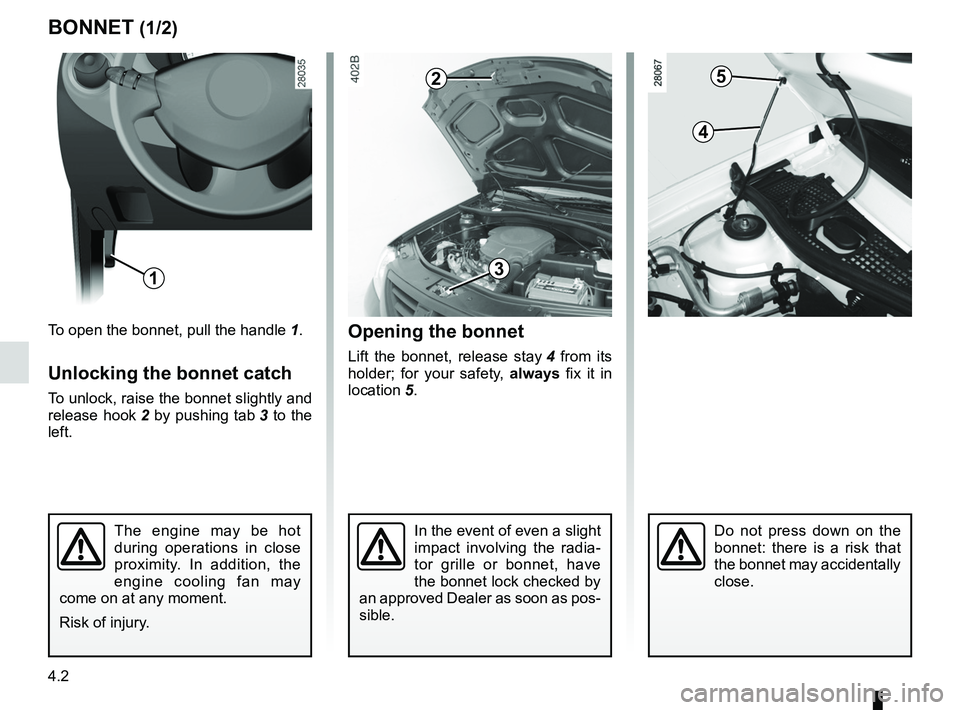
bonnet................................................... (up to the end of the DU)
4.2
ENG_UD22576_6
Capot moteur (B90 - Dacia)
ENG_NU_817-9_B90_Dacia_4
Jaune NoirNoir texte
Bonnet
BONNET (1/2)
The engine may be hot
during operations in close
proximity. In addition, the
engine cooling fan may
come on at any moment.
Risk of injury.In the event of even a slight
impact involving the radia -
tor grille or bonnet, have
the bonnet lock checked by
an approved Dealer as soon as pos-
sible.
1
2
3
4
5
To open the bonnet, pull the handle 1.
Unlocking the bonnet catch
To unlock, raise the bonnet slightly and
release hook 2 by pushing tab 3 to the
left.
Opening the bonnet
Lift the bonnet, release stay 4 from its
holder; for your safety, always fix it in
location 5.
Do not press down on the
bonnet: there is a risk that
the bonnet may accidentally
close.
Page 109 of 183
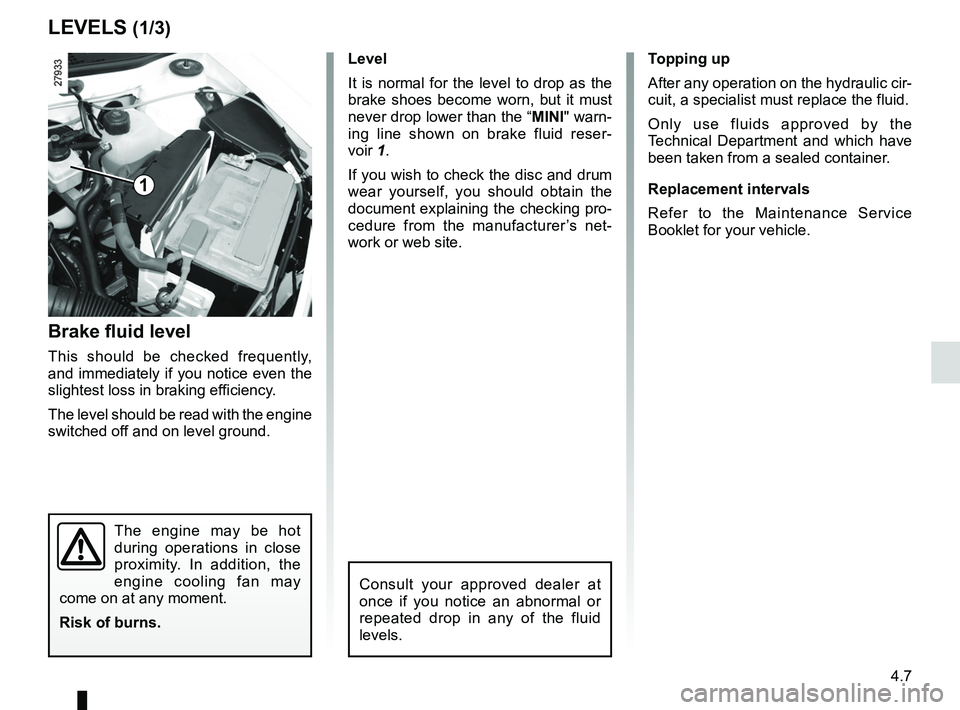
maintenance:mechanical ...................................... (up to the end of the DU)
brake fluid .............................................................. (current page)
levels .................................................... (up to the end of the DU)
tanks and reservoirs brake fluid ........................................................ (current page)
4.7
ENG_UD19766_9
Niveaux / Filtres (B90 - L90 Ph2 - Dacia)
ENG_NU_817-9_B90_Dacia_4
Levels:
Brake fluid
LEVELS (1/3)
Brake fluid level
This should be checked frequently,
and immediately if you notice even the
slightest loss in braking efficiency.
The level should be read with the engine
switched off and on level ground. Level
It is normal for the level to drop as the
brake shoes become worn, but it must
never drop lower than the “MINI" warn-
ing line shown on brake fluid reser
-
voir 1.
If you wish to check the disc and drum
wear yourself, you should obtain the
document explaining the checking pro-
cedure from the manufacturer ’s net -
work or web site.
1
Consult your approved dealer at
once if you notice an abnormal or
repeated drop in any of the fluid
levels.
The engine may be hot
during operations in close
proximity. In addition, the
engine cooling fan may
come on at any moment.
Risk of burns.
Topping up
After any operation on the hydraulic cir-
cuit, a specialist must replace the fluid.
Only use fluids approved by the
Technical Department and which have
been taken from a sealed container.
Replacement intervals
Refer to the Maintenance Service
Booklet for your vehicle.
Page 116 of 183
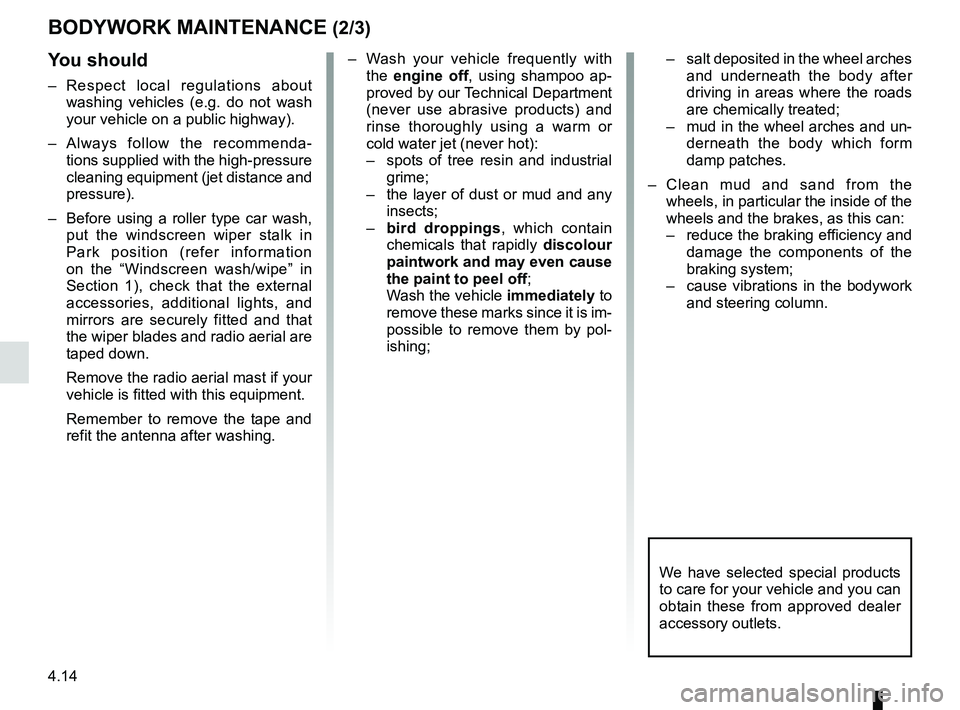
4.14
ENG_UD20155_5
Entretien de la carrosserie (B90 - U90 - L90 Ph2 - F90 Ph2 - R90 Ph2 - \
Dacia)
ENG_NU_817-9_B90_Dacia_4
Jaune NoirNoir texte
BODyWORK MAINTENANCE (2/3)
y ou should
–
Respect local regulations about
washing vehicles (e.g. do not wash
your vehicle on a public highway).
– Always follow the recommenda -
tions supplied with the high-pressure
cleaning equipment (jet distance and
pressure).
– Before using a roller type car wash,
put the windscreen wiper stalk in
Park position (refer information
on the “Windscreen wash/wipe” in
Section 1), check that the external
accessories, additional lights, and
mirrors are securely fitted and that
the wiper blades and radio aerial are
taped down.
Remove the radio aerial mast if your
vehicle is fitted with this equipment.
Remember to remove the tape and
refit the antenna after washing. –
Wash your vehicle frequently with
the engine off , using shampoo ap -
proved by our Technical Department
(never use abrasive products) and
rinse thoroughly using a warm or
cold water jet (never hot):
– spots of tree resin and industrial
grime;
– the layer of dust or mud and any
insects;
– bird droppings , which contain
chemicals that rapidly discolour
paintwork and may even cause
the paint to peel off ;
Wash the vehicle immediately to
remove these marks since it is im-
possible to remove them by pol -
ishing; –
salt deposited in the wheel arches
and underneath the body after
driving in areas where the roads
are chemically treated;
– mud in the wheel arches and un-
derneath the body which form
damp patches.
– Clean mud and sand from the
wheels, in particular the inside of the
wheels and the brakes, as this can:
– reduce the braking efficiency and
damage the components of the
braking system;
– cause vibrations in the bodywork
and steering column.
We have selected special products
to care for your vehicle and you can
obtain these from approved dealer
accessory outlets.